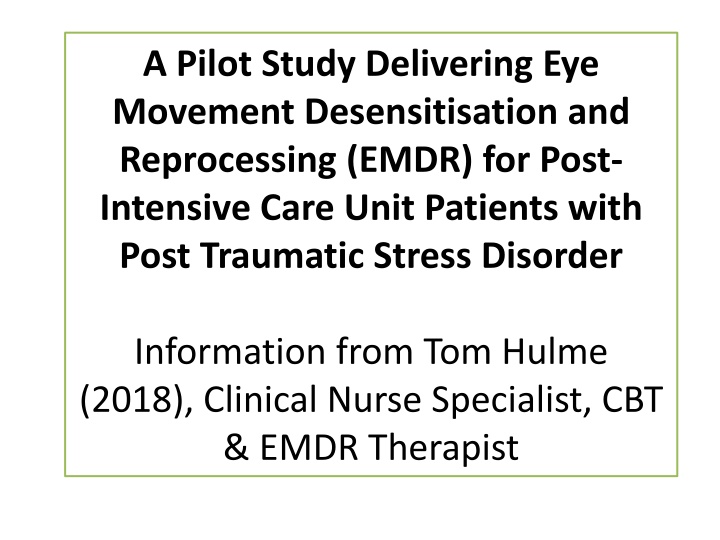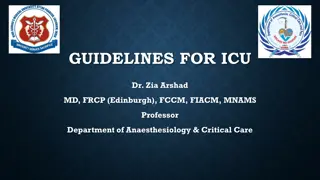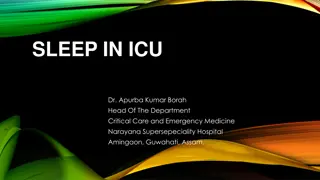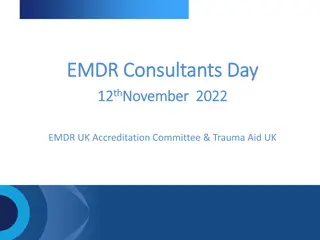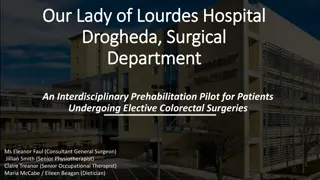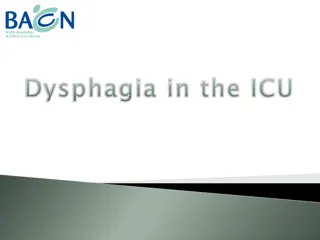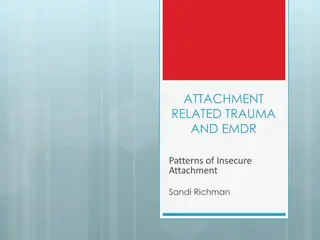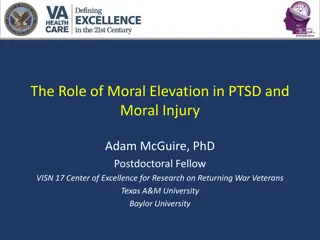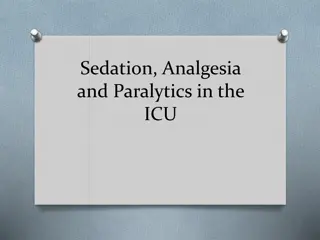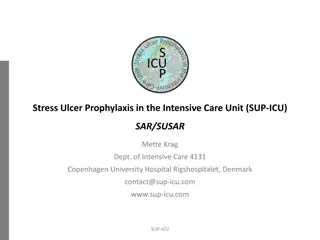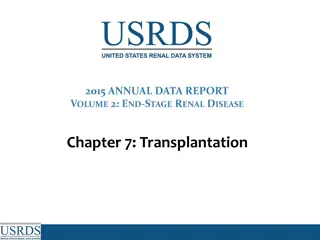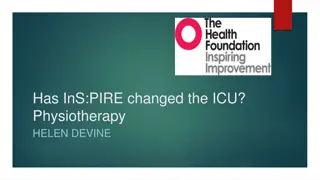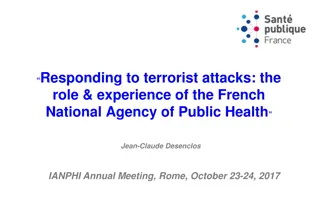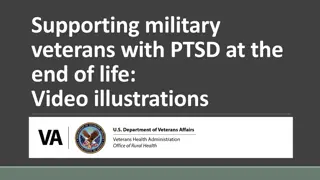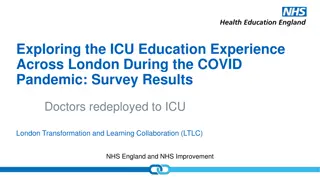Delivering EMDR for PTSD in Post-ICU Patients: A Pilot Study by Tom Hulme
More ICU survivors are experiencing PTSD post-discharge. Symptoms include intrusive thoughts, nightmares, avoidant behavior, and hypervigilance. EMDR therapy is recognized as effective. This pilot study aims to provide evidence-based treatment to improve health outcomes in this patient group.
Download Presentation

Please find below an Image/Link to download the presentation.
The content on the website is provided AS IS for your information and personal use only. It may not be sold, licensed, or shared on other websites without obtaining consent from the author.If you encounter any issues during the download, it is possible that the publisher has removed the file from their server.
You are allowed to download the files provided on this website for personal or commercial use, subject to the condition that they are used lawfully. All files are the property of their respective owners.
The content on the website is provided AS IS for your information and personal use only. It may not be sold, licensed, or shared on other websites without obtaining consent from the author.
E N D
Presentation Transcript
A Pilot Study Delivering Eye Movement Desensitisation and Reprocessing (EMDR) for Post- Intensive Care Unit Patients with Post Traumatic Stress Disorder Information from Tom Hulme (2018), Clinical Nurse Specialist, CBT & EMDR Therapist
Introduction More patients in intensive care units (ICU) are surviving their critical illnesses due to advances in medical care. This has increased awareness of the psychological sequelae of these episodes of care, particularly post-traumatic stress disorder. Post-traumatic stress disorder (PTSD) is defined as a severe anxiety disorder that occurs when a person is exposed to actual or threatened death, serious injury or sexual violence. The exposure can be direct, witnessed or indirect, e.g. by hearing of a relative or close friend who has experienced the trauma.
Symptoms Include: intrusive thoughts or memories about the trauma nightmares related to the traumatic event flashbacks where the person feels like the event is happening again avoiding thoughts or feelings connected to the traumatic event avoiding people or situations connected to the traumatic event negative thoughts or beliefs about one s self or the world which are related to the trauma a distorted sense of blame for one s self or others related to the event being stuck in severe emotions related to the trauma (e.g. horror, guilt, shame, sadness) severely reduced interest in pre- trauma activities feeling detached, isolated or disconnected from other people difficulty concentrating irritability, increased temper or anger difficulty falling or staying asleep Hypervigilance being easily startled (American Psychiatric Association, 2013)
A diagnosis of PTSD can only be made if the person continues to experience pervasive symptoms for at least one month after the traumatic event. According to previous studies, PTSD affects between 8% to 27% of ICU patients compared to 6% to 8% of the general population Eye movement desensitisation and reprocessing therapy (EMDR) is recognised by the World Health Organisation (2013) and the National Institute for Clinical Excellence (2005) as an effective treatment for PTSD.
Aim To deliver a time-limited, evidence-based treatment for PTSD in order to demonstrate positive health outcomes for this patient group.
Methods The pilot clinic started on 1st June 2016 and ran for 11 months. One of the liaison psychiatrists would visit the intensive care unit each week in order to identify possible high-risk patients for PTSD. As a formal diagnosis of PTSD cannot be made within the first month following the trauma, the psychiatrist s role was one of offering support, validation and normalising of their symptoms. In order to screen these patients after the one month cut-off period, both the patient and their GP were sent an Impact of Event Scale - Revised (IES-R) along with a covering letter, explaining that if they were still experiencing symptoms, they could contact the clinic directly in order to be offered an assessment.
Results 817 letters to patients/GPs. Of the 29 responses: 14 met criteria for PTSD based on their IES-R score 8 failed to return IES-R 5 did not meet criteria for a diagnosis of PTSD 2 with PTSD diagnosis unable to attend BRI weekly, so advised to attend their local psychological therapy service Therefore 14 patients invited into therapy: 3 dropped out after 1-2 sessions and 1 decided not to proceed at all 10 completed treatment: Mean IES score went from 62 to 16 Mean BDI score went from 25 to 9 Mean number of treatment sessions = 5
The pilot study demonstrated excellent outcomes in delivering EMDR therapy to ICU patients with significant PTSD. One drawback was the low numbers who took up the offer of therapy, despite there potentially being a much greater number based on previous research and despite sending out over 800 invitation letters. Any future initiative will look at how these numbers could be improved, although it was also acknowledged that any prospective patients cannot be forced to undertake therapy. One possible reason for these low numbers may have been that due to their PTSD symptoms, patients were reluctant to return to the scene of their previous trauma, e.g. ICU, due to the associated overwhelming re-experiencing symptoms and distress. One consideration could be to offer out-patient clinics away from the hospital site or even in the patients homes.
Increasing recognition The programme was funded by a one-time external grant which was not repeated. Regular psychiatric input has now been lost. Ad-hoc referrals to Liaison Psychiatry are made for some patients who look like they are at particular risk, but by definition, you cannot make a PTSD diagnosis until at least 1 month after the event, by which time most patients are no longer on ICU. Discharge summaries to GPs have been improved so they have a better understanding of what happened to the patient on ICU, as the hospital discharge summary often has minimal detail. The ICU discharge summary is now automatically emailed to the GP practice. It is a service that ICU want to offer that would improve the patient experience for all patients, including those admitted post cancer treatment.
Videos for patients and their relatives Your stay on the Intensive Care Unit at the Bristol Royal Infirmary: https://www.youtube.com/watch?v=SyeQ3kgnU pU Undergoing surgery at the Bristol Royal Infirmary: https://www.youtube.com/watch?v=SGLcj64fqbc
